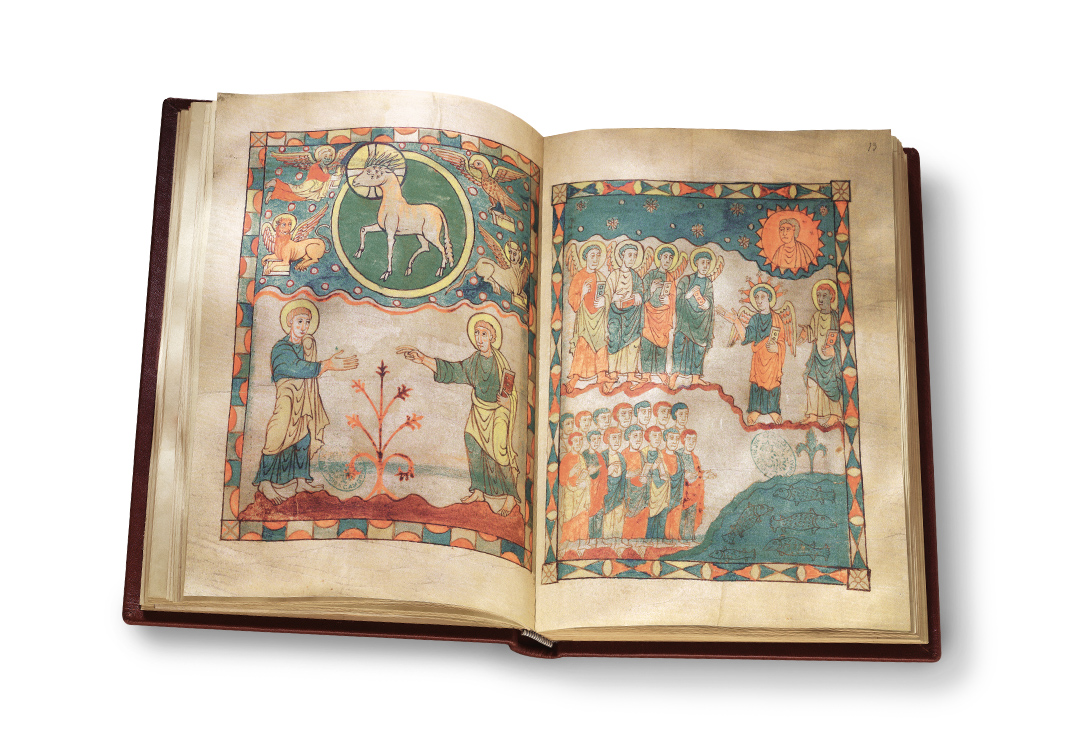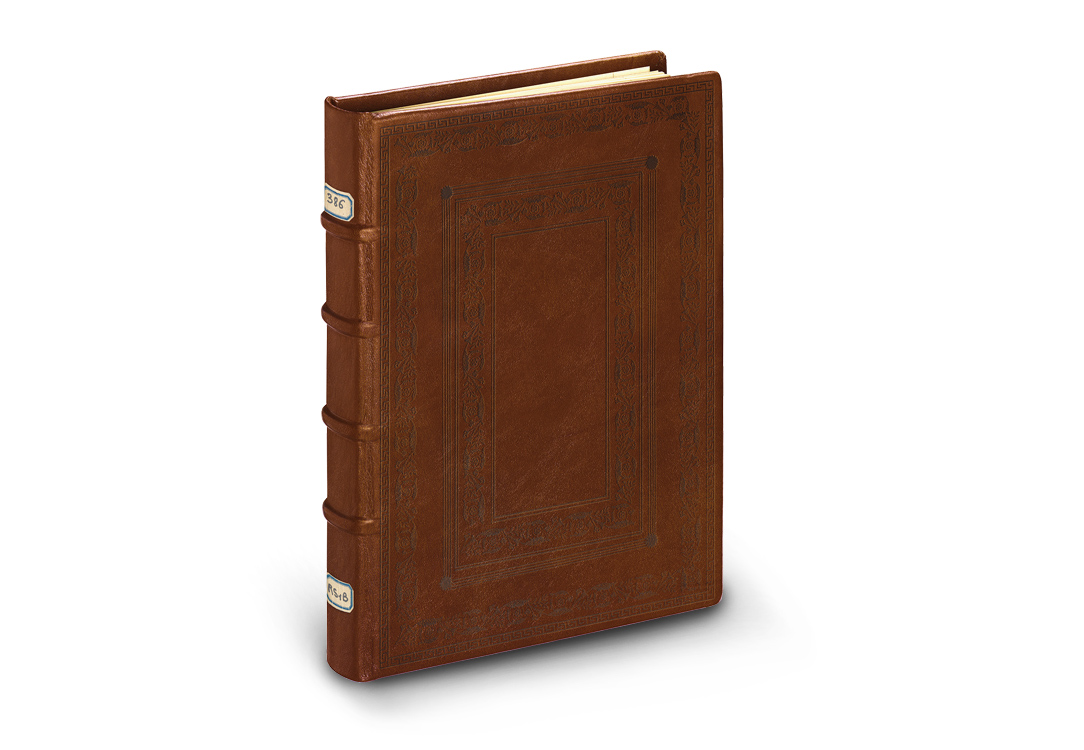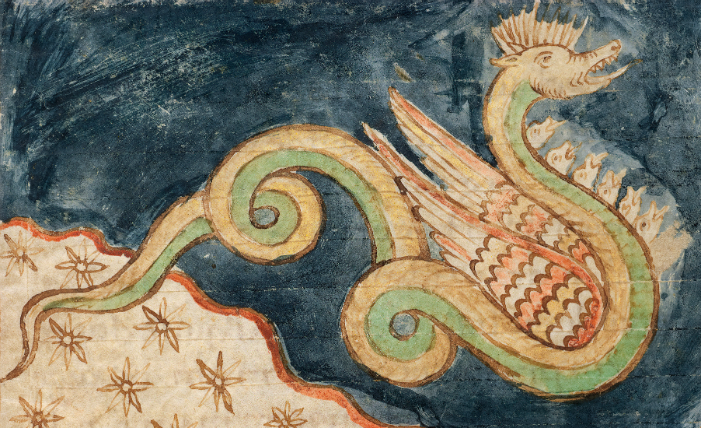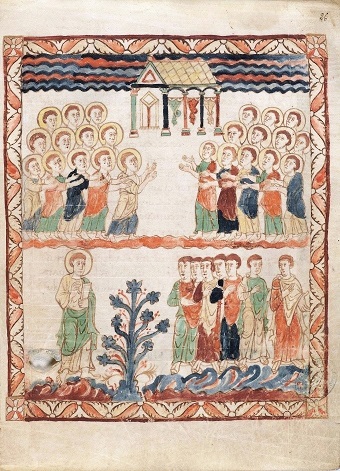The Cambrai Apocalypse
The Exquisite Art of Carolingian Illumination
The Cambrai Apocalypse shines mysteriously as a beacon from past centuries – created more than 1100 years ago, this pictorial treasure trove has survived the turmoil of past centuries and two World Wars in surprisingly good condition. The forty-six full-page illustrations of the Apocalypse present a vividly coloured pictorial narrative which evokes a feeling of confidence even though the subject matter is the end of time. Evidently inspired by Late Antiquity and enriched with Frankish elements, this book illumination testifies to the great art of the Carolingian period.
The facsimile edition by Quaternio Editions Lucerne makes this rich and imaginative book illumination accessible to the public and provides the interested viewer with an authentic and lively experience of its high artistic quality.
Apokalypse von Cambrai
The Cambrai Apocalypse: The Manuscript
Magical Images
Even after more than a millennium, the effect of the powerful images depicted in the Cambrai Apocalypse remains undiminished. Each page illustrates a cryptic Bible text: the Apocalypse of John. Only four Apocalypse manuscripts from the ninth century have survived. Of these, the Cambrai Apocalypse is certainly the most vibrant manuscript, uniquely offering a wealth of narrative images. The forty-six full-page miniatures stand out thanks to their dynamic compositions and a certain touch of serenity. The colour scheme is varied and fresh: pleasant hues of blue, ochre, yellow and green are harmoniously combined, and the surfaces are carefully filled in. These wonderful images invite the viewer to linger in this world!
Visions of the End of Time
Apocalypses are texts describing prophecies and visions of the imminent end of the world. They often involve the concepts of the final judgement and the divine renewal of the world. The secret Revelation of John is the only apocalyptic text accepted into the New Testament canon. The powerful language using almost surrealistic figures of speech has always inspired the creativity and imagination of artists translating the apocalyptic visions into the pictorial vocabulary of their time. Thus, every Apocalypse manuscript is unique. In contrast to later manuscripts, the Cambrai Apocalypse shows no drastic representations of monsters, devils or punishments in Hell.
The Carolingian Renaissance
The Cambrai Apocalypse is associated with the so-called Carolingian Renaissance. This comprehensive development was initiated and propagated by Charlemagne and the Aachen Palace School. Apart from involving politics and the Church it was an extensive cultural renewal of the kingdom. There were efforts to reform the language, script and liturgy, coupled with a growing interest in the authors of Late Antiquity and a desire to emulate Antique art. During the ninth century, this renewal was continued by religious centres in Tours, Reims and Metz. It also reached Cambrai, where the colourful Apocalypse manuscript could have been destined for one of the major churches.
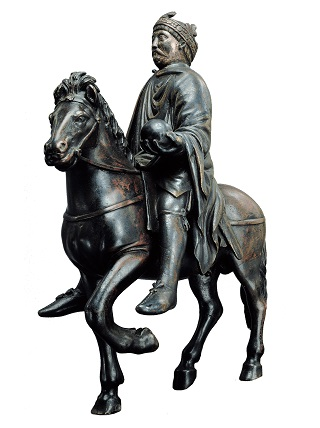
Apokalypse von Cambrai
Under the Magnifying Glass: Modelled on the Art of Christian Late Antiquity
The artists of the Cambrai Apocalypse are visibly inspired by Late Antique painting: temple buildings with columns, Corinthian capitals and palmettes are among the decorative elements used. The figures depicted are juvenile and beardless, wearing a tunic, toga or sandals, while others are barefoot like Antique gods. Often arranged in registers and displaying bold and clear contours, the miniatures are clearly structured. The two-dimensional figures have large eyes and gesture animatedly with raised hands, thus radiating a special vitality. These elements – as well as the highly stylized plants and trees – are characteristic of an early stage in the style to be taken up by Ottonian book illumination, though they appear in an exaggerated manner.
The miniature on fol. 26r is a good example of the style, which emulates Antiquity. The upper half shows the open Temple with the Ark of the Covenant and the 24 Adoring Elders who praise the Lord who “has taken his great power and who reigns” (Apoc. 11:15–19). The temple is depicted as an Antique building with columns and a pointed tiled roof. The knotted curtains in the lateral arcades are possibly intended to indicate the opening of the temple. In the front arcade, the “ark of the covenant” appears as a diagonally placed chest covered with a fringed cloth. Below the temple, the 24 Elders are arranged in two separate groups. In the lower register, depicted with a nimbus and clad in a toga, John addresses the seven churches of Asia Minor.
Apokalypse von Cambrai
The Cambrai Apocalypse: The Edition
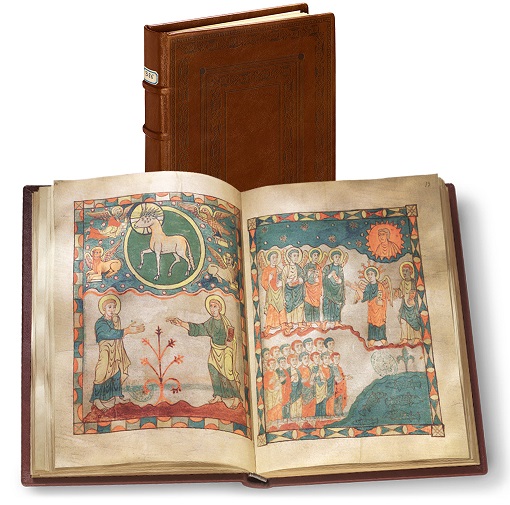
The Manuscript and the Facsimile at a Glance
The Cambrai Apocalypse is the most renowned manuscript of the public library of Cambrai. Providing an authentic experience of this manuscript, the facsimile is outstanding not only for its visual quality but also, due to the special parchment-like paper, for its special touch and sound.
Manuscript: Cambrai, Médiathèque d’Agglomération de Cambrai, Ms. B 386
Date of Origin: end of 9th century
Places of Origin: France (Cambrai?)
Dimensions: c. 31.0 x 23.0 cm
Extent: 96 pages (48 leaves)
Artists: unknown, presumably several painters
Patron: unknown
Illumination: 46 full-page miniatures in vibrant colours, each illustrated page surrounded by varied, fancifully patterned decorative frames, each text page surrounded by less elaborate coloured frames
Binding: richly decorated leather binding with geometrical and floral motifs, executed in delicate blind-stamping (original from the 18th century)
Commentary Volume for the Facsimile Edition by Franck Cinato / Peter K. Klein / Fabien Laforge
Print run: 680 copies
Apokalypse von Cambrai
Enjoy Viewing 10 Sample Pages:
A Glance at the Facsimile
The section from the Cambrai Apocalypse reproduced here shows fols. 6r–10v. Each miniature features a decorated frame with a different pattern, and the frames surrounding the illustrated pages show particularly rich and fanciful decorations.
Composed in fresh, harmonious colours, the illustrations show: the Letter to the Church of Sardis (fol. 6v), the Letter to the Church of Philadelphia I (fol. 7v), the Letter to the Church of Philadelphia II and the Letter to the Church of Laodicea I (fol. 8v), the Letter to the Church of Laodicea II (fol. 9v), and the Vision of the Enthroned (fol. 10v).
Apokalypse von Cambrai
A Challenging Production: fac simile
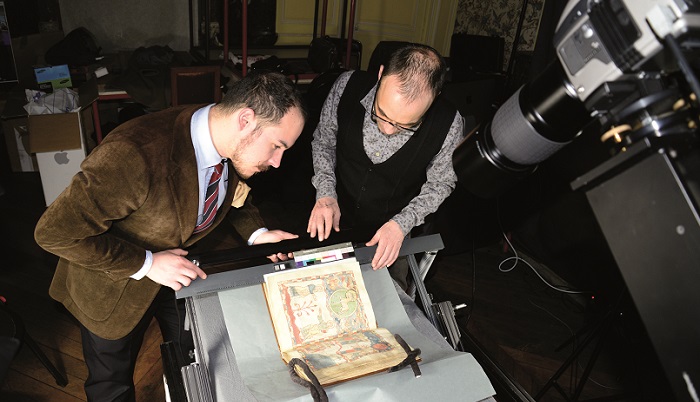
State-of-the-Art Technology
In reproducing the facsimile of the Cambrai Apocalypse true to the original, we observe the highest standards, as with all our editions. Specialists in digitalisation begin by taking photographs with due diligence on the premises of the library in Cambrai. A lithographer then prepares the digital data for printing. He compares the printing proofs with the original while paying special attention to the colours, so that those in the facsimile exactly match those of the manuscript, which is over one thousand years old. After several proof runs have been checked and corrected, the printing is executed on the special parchment-like paper while the quality is continuously monitored.
The Traditional Craft of Bookbinding
Subsequently, the bookbinder of today largely employs the same manual techniques as those used in past centuries. He folds the printed sheets, assembles them in sections, and works at the sewing frame to attach them to each other to form the book-block. Even the headband is embroidered by hand. The book-block is hand-fastened to the book boards, and leather of the best quality matching the original colour shade is chosen for the book cover. The present-day binding, dating from the 18th century, is decorated with blind stamps showing geometrical and floral designs. Great accuracy is needed in cutting the tools for the cover design. Finally, two shelf mark plates are glued to the spine.
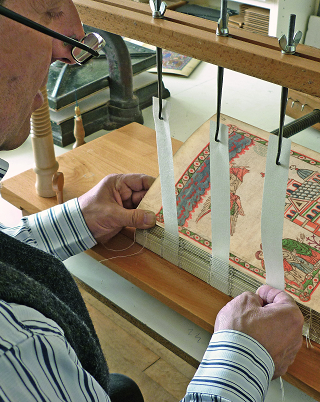
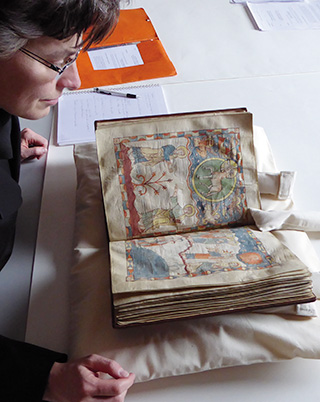
Apokalypse von Cambrai
The Facsimile Folder for the Edition
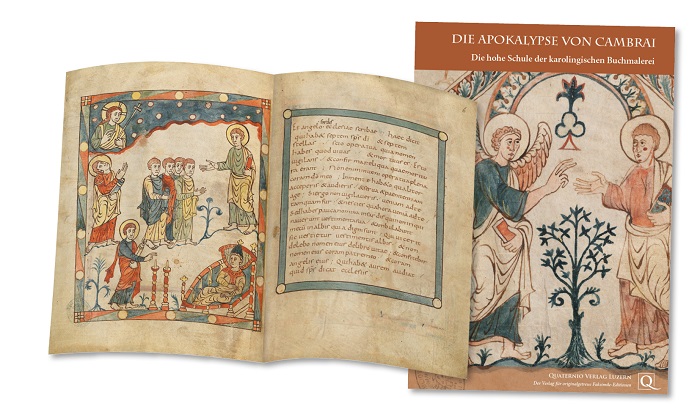
Lively images in harmonious compositions displaying a wide range of vibrant and fresh colours! A masterpiece of Carolingian book illumination presented as a masterpiece of modern facsimile production!
Accompanying the Cambrai Apocalypse, Quaternio Editions Lucerne has created a linen-bound documentation folder for you. Measuring 39.5 x 28.0 cm, it contains four pages of a facsimile double-leaf. The slightly wavy special paper of the facsimile edition gives you an authentic impression of how it feels to touch and turn the pages of an 1100-year-old parchment manuscript. Detailed captions explain the two miniatures depicted on the enclosed facsimile double-leaf. In a richly illustrated brochure, learn more about this exceptional illuminated manuscript from the Carolingian period.
Apokalypse von Cambrai
Order facsimile folder
Click here to go to the online shop (German only) where you can order the facsimile folder for the Cambrai Apocalypse edition. Or send us an email to info@quaternio.ch.
Request brochure
We would be glad to provide you with additional information regarding the fine art facsimile edition of the Cambrai Apocalypse. Click here to order the brochure.




